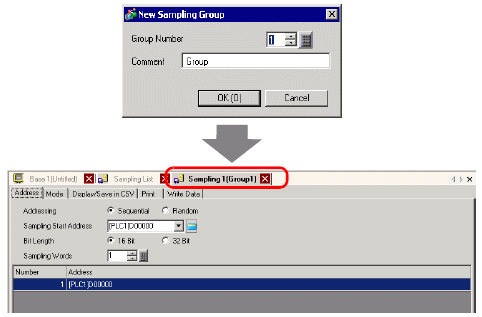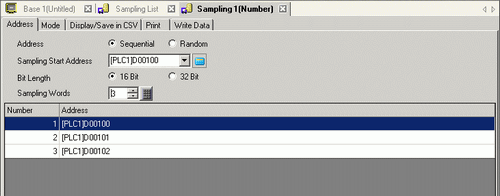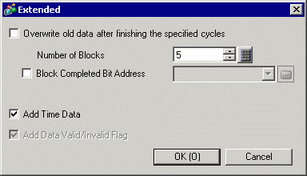![]()
Please refer to the Settings Guide for details.
 24.8 Common (Sampling) Settings Guide
24.8 Common (Sampling) Settings Guide
![]()
Please refer to the Settings Guide for details.![]() 24.8 Common (Sampling) Settings Guide
24.8 Common (Sampling) Settings Guide
Configure settings to sample data from D100, D101, and D102 every time the bit (M100) turns ON.
In the [Common Settings (R)] menu, select the [Sampling (D)] command or click ![]() , and the following screen appears.
, and the following screen appears.

Click [Create] and the following dialog box appears. Set the sampling group number, click [OK], and the sampling settings screen appears.

In [Sampling Start Address], set the start address (D100) for data you want to sample.
Designate the bit length to store for sampled data, and in [Sampling Words], set the number of addresses. The first three words are displayed, starting from the designated address.

On the [Mode] tab, for the [Execution Condition] select [Bit ON].

In [Sampling Trigger Bit Address], set the bit address (for example, M100) to control the data sampling operation. Data sampling runs every time this bit turns ON.
![]()
Designate the number of times to sample the data (for example, 4 times).
![]()
Set up the address (for example, M50) to delete the sampling data. When this bit is turned ON, all data from sampling group 1 stored in the display unit is deleted.
Designate the [ACK Bit Address] (for example, M20) which will confirm when the data reading is finished. When the data reading is finished, this bit turns ON. Accept this Bit ON and turn OFF the [Sampling Trigger Bit Address] (M100).
(When M100 turns OFF, M20 turns OFF.))

When data for the designated number of times (for example, 4) specified in step 7 is saved on the display unit and the trigger bit (M100) turns ON for the 5th time, data will be overwritten and stored in order starting from the 1st time's data.
If you do not want data to be overwritten, clear the [Overwrite old data after finishing the specified cycles] check box in the [Advanced Object Configuration] dialog box. When the designated bit turns ON for the 5th time, sampling will not occur.
Click [Extended] and the following dialog box appears.
If you clear the [Overwrite old data after finishing the specified cycles] check box, you can adjust the [Number of Blocks] setting. A "block" is the sampling data collected from the designated Occurrences. When displaying or printing data, you can use block units.
For example, sampling for five days from Monday to Friday and displaying/printing data by each day.

The sampled data for the designated Occurrences is one block. Specify how many blocks.
![]()
For information about the timing of the Sampling action, please refer to the following.![]() 24.11.2.1 Timing for Collecting Data
24.11.2.1 Timing for Collecting Data
When the [Backup to Internal Memory] checkbox is not selected, the sampling data stored in the display unit is erased when the display unit is turned OFF or reset.